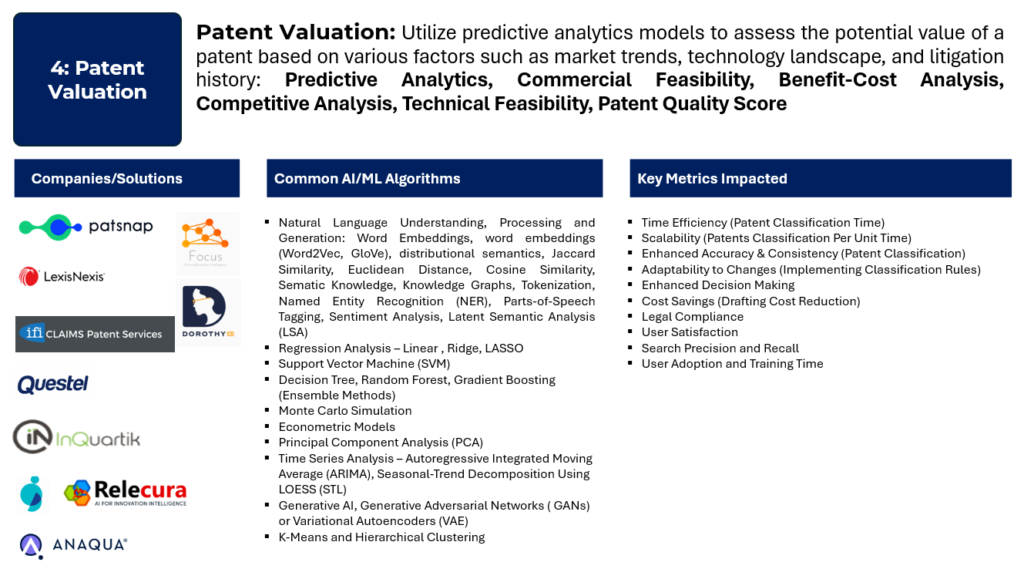Artificial Intelligence (AI) and Machine Learning (ML) can significantly impact patent management by automating and optimizing various tasks. By leveraging AI and ML in these areas, patent management processes can become more efficient, accurate, and proactive, ultimately enhancing the overall effectiveness of intellectual property management strategies. There are several applications and areas where AI/ML can be applied in patent management: Prior Art Search, Automated Patent Drafting, Patent Classification, Patent Valuation, Automated Patent Filing and Prosecution, Patent Portfolio Management, Patent Analytics, Infringement Detection, Technology Landscape Analysis, Patent Litigation Support, Automated Patent Maintenance and Collaborative Innovation Platforms.
D: Patent Valuation
AI/ML is increasingly being applied in the field of patent valuation to provide more accurate and data-driven assessments of the economic value of intellectual property. Patent valuation involves estimating the financial worth of patents based on various factors such as technological relevance, market potential, and competitive landscape. AI algorithms analyze the technological content of patents, considering factors such as citations, references, and the technical details within the documents. Provides insights into the significance of the patented technology in relation to industry trends and advancements. AI/ML helps in predicting potential risks and challenges associated with patents, allowing companies to proactively address issues. AI/ML technologies in patent valuation empower companies to assess the economic value of their intellectual property more accurately, enabling strategic decision-making and portfolio optimization. Platforms like PatSnap, IPlytics, and Cipher demonstrate how these technologies are integrated into comprehensive patent analytics solutions.
PatSnap’s platform incorporates AI-driven features for patent valuation. It uses machine learning algorithms to analyze patent data and provides users with insights into the economic and strategic value of patents. Companies can make strategic decisions regarding their patent portfolios based on data-driven insights. Users can identify high-value patents, assess technology gaps, and optimize their patent portfolios for maximum economic impact. IPlytics offers a platform that leverages AI to analyze patent data, market information, and technology landscapes. It provides users with tools for patent valuation, competitive intelligence, and technology benchmarking. Cipher’s patent analytics platform uses AI to assess patent portfolios for valuation and strategic decision-making. It employs machine learning to identify trends, risks, and opportunities within patent datasets.
Quantify IP (Patent Portfolio Estimator): Quantify IP offers the Patent Portfolio Estimator, which employs AI/ML techniques for patent valuation. It assists in estimating the economic value of patent portfolios and individual patents. GreyB (Value Insights): GreyB provides Value Insights, a platform that uses AI/ML for patent valuation. It aims to help users understand the economic and competitive value of patents. Relecura: Relecura is an IP analytics platform that incorporates AI for various tasks, including patent valuation. It offers features for portfolio analysis, technology landscapes, and valuation assessments. InQuartik Corporation (Patentcloud – Patent Search & Analytics): InQuartik’s Patentcloud platform includes tools for patent valuation and analytics. It utilizes AI-driven algorithms to provide insights into patent value and competitive landscapes. IFI CLAIMS Patent Services: IFI CLAIMS Patent Services is known for its patent data solutions. While not exclusively focused on valuation, the company’s data services may be used in combination with AI for assessing patent value. Anaqua (AQX): Anaqua provides IP management solutions, including AQX, which includes tools for patent valuation. The platform aims to assist in managing and maximizing the value of intellectual property portfolios. Questel (Orbit Intelligence): Questel offers IP management and intelligence solutions, including Orbit Intelligence. The platform incorporates AI for patent analytics and valuation assessments.

AI/ML algorithms can be applied to patent valuation to analyze and assess the value of intellectual property assets. Regression Analysis: Predicting the value of patents based on various features. Establishing relationships between patent characteristics and their financial value. Linear Regression, Ridge Regression, LASSO Regression. Decision Trees: Identifying key factors influencing patent valuation. Decision trees can help in understanding the hierarchy of variables affecting patent value. Decision Tree, Random Forest. Support Vector Machines (SVM): Classifying patents into different valuation categories. SVM can be used for binary or multiclass classification based on various patent features. Support Vector Machines. Neural Networks: Modeling complex relationships between input features and patent valuation. Neural networks can capture intricate patterns in large datasets for accurate valuation. Artificial Neural Networks (ANN), Deep Learning Models. Ensemble Learning: Combining multiple models to improve accuracy and robustness. Ensemble methods can enhance the overall performance of the valuation model. Random Forest, Gradient Boosting. Clustering Algorithms: Grouping patents with similar valuation characteristics. Clustering can identify distinct segments of patents with similar values. K-means Clustering, Hierarchical Clustering. Principal Component Analysis (PCA): Reducing dimensionality and identifying significant features. Application: PCA can be used to reduce the number of variables while retaining valuable information for valuation.
Principal Component Analysis.
Natural Language Processing (NLP): Extracting insights from patent texts and documents. Analyzing patent language and text for indicators of value. Named Entity Recognition (NER), Latent Semantic Analysis (LSA), Word Embeddings. Time Series Analysis: Analyzing the temporal aspects of patent value. Evaluating how the value of patents changes over time. Autoregressive Integrated Moving Average (ARIMA), Seasonal-Trend decomposition using LOESS (STL). Monte Carlo Simulation: Simulating various scenarios to estimate patent value. Assessing the uncertainty and risk associated with patent valuation. Econometric Models: Incorporating economic variables to estimate patent value. Modeling the economic factors affecting the valuation of patents. Various econometric models based on economic principles.
Using AI/ML for patent valuation can lead to various benefits and improvements in key performance indicators (KPIs) and metrics. The objectives and key results (OKRs) may vary based on specific organizational goals, but here are some common benefits and performance indicators impacted by AI/ML in patent valuation. Regularly monitoring these performance indicators allows organizations to assess the effectiveness of AI/ML applications and make data-driven improvements to their patent valuation processes.:
Accuracy and Precision: Improve the accuracy and precision of patent valuations. Reduction in valuation errors. Increased correlation between AI/ML-derived valuations and actual market values. Efficiency and Time Savings: Increase efficiency in the patent valuation process. Reduction in the time taken for patent valuations. Increased throughput in processing patent portfolios. Consistency in Valuation: Enhance consistency in assessing patent values. Reduced variability in valuation results. Consistent application of valuation criteria. Scalability: Enable scalable patent valuation processes. Ability to handle a growing volume of patent portfolios. Scalability of the AI/ML model for increased data inputs. Cost Savings: Achieve cost savings in the patent valuation workflow. Reduction in labor costs associated with manual valuation. Lower overall costs in the patent valuation process. Risk Assessment and Mitigation: Improve risk assessment associated with patent valuations. Identification and mitigation of risks in patent portfolios. Enhanced accuracy in predicting potential legal challenges.
Market and Technology Trends Analysis: Incorporate market and technology trends in patent valuation. Integration of real-time market data for valuation. Timely adaptation to emerging technology trends. Portfolio Optimization: Optimize the value of patent portfolios. Improved understanding of the most valuable patents within a portfolio. Optimization of portfolio composition for strategic goals. User Satisfaction: Objective: Enhance user satisfaction with the patent valuation process. Positive feedback from users and stakeholders. User-friendly interfaces and tools for patent valuation. Prediction Accuracy: Increase the accuracy of predicting future patent values. Improved accuracy in forecasting the future value of patents. Better alignment between predicted and actual future values. Innovation Strategy Alignment: Align patent valuations with the organization’s innovation strategy. Alignment between high-valued patents and strategic innovation goals. Patents contributing to innovation objectives are accurately valued. Cross-Functional Collaboration: Facilitate collaboration between AI/ML experts and patent professionals. Successful integration of AI/ML models into the patent valuation workflow. Collaborative knowledge-sharing between different teams.
References
Patent Valuation:
Book: “Valuation of Intellectual Property and Intangible Assets” by Gordon V. Smith and Russell L. Parr
Article: “Intellectual Property Valuation: A Review” by Pablo Fernandez (SSRN, 2016)
White Paper: “A Guide to Intellectual Property Valuation” by Deloitte
Online Resource: “Introduction to Patent Valuation” on IPWatchdog
Course: “IP Valuation and Management” on WIPO Academy




